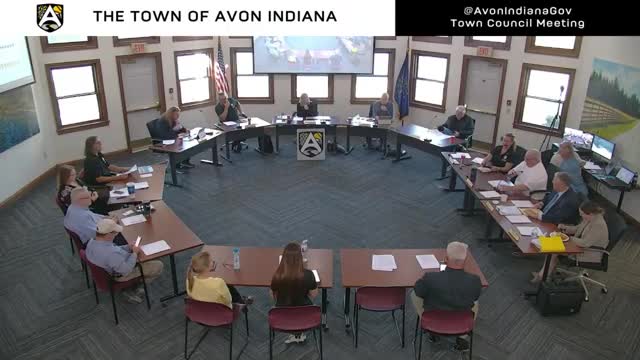Town staff present life‑cycle pavement model; staff say current program is holding road conditions steady
October 10, 2025 | Avon Town, Hendricks County, Indiana
This article was created by AI summarizing key points discussed. AI makes mistakes, so for full details and context, please refer to the video of the full meeting. Please report any errors so we can fix them. Report an error »

Public works staff presented the town’s new life‑cycle pavement model at the Oct. 9 public works work session, describing the tool as a way to project street conditions under different spending scenarios. The presentation summarized 25 years of pavement-condition data, described modeling assumptions and produced scenario outputs by annual paving budget.
The model is intended “to be a decision‑making tool” based on staff’s description, and staff emphasized it complements — rather than replaces — field inspections. “There’s still a human factor,” the presenter said, noting staff will override the model when field observations differ from model recommendations.
Key findings presented: under the town’s baseline annual paving budget of $1,260,000, the model projects relatively stable system condition over the next five to 10 years; doubling the annual paving budget to $2,520,000 showed only modest improvement; and an “unlimited” budget produces only a small incremental benefit above the baseline. Staff said the town’s preservation treatments have produced an unusually long degradation curve — the consultant customized the model to reflect a roughly 40–50 year degradation timeframe rather than a typical 20‑year curve.
Staff described the modeling inputs and calibration steps, including treating crack sealing and reclamite applications as producing modest PASER improvements in the model so simulated degradation better matched observed conditions. The presenter warned that certain model outputs — for example a start‑of‑program backlog that implied a $7.5 million first‑year investment — reflect the model’s default triggers (e.g., treating all PASER 4 sections as needing reinforced overlays) and do not represent an immediate staff request for a large appropriation.
Public works staff demonstrated a map and the model interface that lists every road and its current condition, and a recommended multi‑year treatment list staff can export for operational planning. Staff said they will rerun the model annually and use it to inform the capital program, though they did not recommend relying on the tool without continued crew inspections. “What we’re spending is a sufficient amount of money,” the presenter said, summarizing staff’s interpretation of the scenarios.
Staff took questions from council members about overlay types and pavement reinforcement and said the software can be used to identify low‑priority roads that may need attention before they become costly full‑depth replacements. The presentation and the tool’s exported maps and treatment schedules will be provided to council as follow‑up materials.
The model is intended “to be a decision‑making tool” based on staff’s description, and staff emphasized it complements — rather than replaces — field inspections. “There’s still a human factor,” the presenter said, noting staff will override the model when field observations differ from model recommendations.
Key findings presented: under the town’s baseline annual paving budget of $1,260,000, the model projects relatively stable system condition over the next five to 10 years; doubling the annual paving budget to $2,520,000 showed only modest improvement; and an “unlimited” budget produces only a small incremental benefit above the baseline. Staff said the town’s preservation treatments have produced an unusually long degradation curve — the consultant customized the model to reflect a roughly 40–50 year degradation timeframe rather than a typical 20‑year curve.
Staff described the modeling inputs and calibration steps, including treating crack sealing and reclamite applications as producing modest PASER improvements in the model so simulated degradation better matched observed conditions. The presenter warned that certain model outputs — for example a start‑of‑program backlog that implied a $7.5 million first‑year investment — reflect the model’s default triggers (e.g., treating all PASER 4 sections as needing reinforced overlays) and do not represent an immediate staff request for a large appropriation.
Public works staff demonstrated a map and the model interface that lists every road and its current condition, and a recommended multi‑year treatment list staff can export for operational planning. Staff said they will rerun the model annually and use it to inform the capital program, though they did not recommend relying on the tool without continued crew inspections. “What we’re spending is a sufficient amount of money,” the presenter said, summarizing staff’s interpretation of the scenarios.
Staff took questions from council members about overlay types and pavement reinforcement and said the software can be used to identify low‑priority roads that may need attention before they become costly full‑depth replacements. The presentation and the tool’s exported maps and treatment schedules will be provided to council as follow‑up materials.
View full meeting
This article is based on a recent meeting—watch the full video and explore the complete transcript for deeper insights into the discussion.
View full meeting
